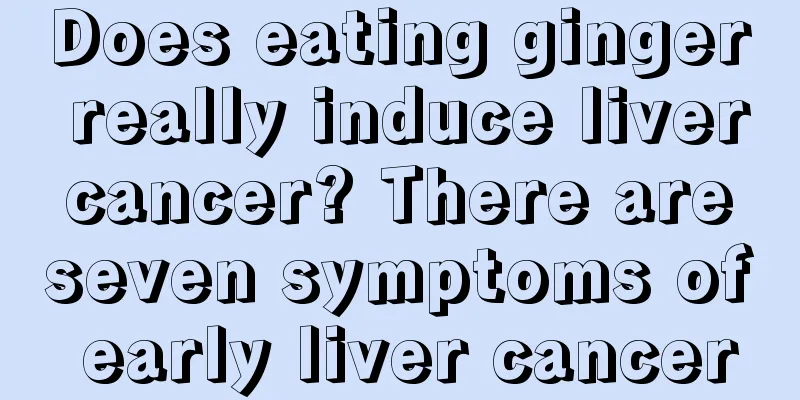Does eating ginger really induce liver cancer? There are seven symptoms of early liver cancer

|
Recently, rumors that "eating ginger can cause liver cancer" have been spreading. "Ginger contains a carcinogen called safrole, which can easily induce liver cancer. my country's regulations on the management of precursor chemicals implemented in 2005 also listed safrole as a precursor chemical. Don't eat ginger anymore. It's too scary. It's simply chronic suicide." Recently, the news that ginger can induce liver cancer was forwarded by a large number of netizens in the circle of friends, causing some netizens to worry. What is the real situation? Let's find out together. The rumor originated from a study in the United States It is understood that the rumor mainly originated from a study by the US FDA. Ginger contains an ingredient that is unhealthy - safrole. American studies have shown that safrole can cause liver cancer. Adding 0.04% to 1% safrole to the feed of mice for 150 days to 2 years can induce liver cancer in mice. The process of safrole being metabolized into active carcinogens is now relatively clear: safrole is first metabolized into phenylethanol in the mouse body, and then activated and converted into acetate or sulfate, becoming the final carcinogen. If safrole is combined with an oxidant, it will produce epoxy safrole with stronger carcinogenic activity. Eating ginger in moderation will not induce liver cancer Safrole is mainly found in natural aromatic oils such as sassafras oil, camphor oil, Brazilian sassafras oil, and North American sassafras oil. These raw materials may be used to make edible natural flavors. In addition, ginger, cardamom, laurel and other condiments also contain a small amount of safrole. The "Guidelines for the Use of Flavors" being formulated by the Codex Alimentarius Committee stipulates that the maximum limit of safrole in food and beverages is 1 mg/kg. The rumor that "eating ginger may cause liver cancer" has some basis and reason. However, eating ginger in moderation is not closely related to cancer and will not necessarily lead to cancer. If you refuse to eat ginger for this reason, it would be a bit of an overreaction. First of all, safrole is a Class 2 carcinogen, and its carcinogenic effect is far less strong than aflatoxin. Secondly, the safrole content in unmolded ginger is very small. If you only add some in cooking, it will never reach the warning line of 1 mg/kg. Eating bad ginger or overeating ginger is another matter. The harmful substances such as safrole produced by bad ginger will increase rapidly, and long-term consumption will increase the risk of cancer. If consumers find that the ginger core has turned black, turned bran, or sprouts have grown on the ginger, it means that the ginger has gone bad. In addition, ginger will grow white hair when it is heated and will produce toxins when it is frozen. Do not buy and eat such "abnormal ginger". There are seven symptoms of early liver cancer Symptom 1: Pain in the liver area The vast majority of patients with advanced liver cancer present with pain in the liver area as the first symptom, with an incidence rate of over 50%. Pain in the liver area is generally located in the right ribs or under the xiphoid process, and the pain is intermittent or persistent. It is dull or stabbing, and the patient may feel discomfort in the right upper abdomen for a period of time before the pain. The pain may be mild or severe or relieve itself in the short term. The main cause of the pain is the rapid enlargement of the tumor, which compresses the liver capsule and produces pulling pain. It can also be caused by the necrosis of the tumor irritating the liver capsule. A small number of patients experience severe pain in the liver area spontaneously or suddenly after liver puncture, which is mostly caused by ruptured and bleeding cancerous nodules located on the surface of the liver. If accompanied by a drop in blood pressure and shock, and bloody fluid is found in abdominal puncture, it means that the cancerous nodules are severely ruptured and bleeding. In this case, emergency rescue is required. If there are no accompanying symptoms and the pain is more localized, it indicates that the bleeding is under the liver capsule. The pain may vary depending on the location of the tumor. Tumors located in the left lobe often cause pain in the upper and middle abdomen; tumors located in the right lobe cause pain in the right hypochondrium; when the tumor involves the diaphragm, the pain radiates to the right shoulder or right back, which can easily be mistaken for shoulder arthritis; when the tumor is located in the posterior segment of the right lobe, it can sometimes cause Low back pain. Patients with tumors located deep in the liver generally rarely feel pain. Symptom 2: Digestive tract symptoms According to incomplete statistics, about 37% of liver disease patients mistakenly think they have "stomach disease" in the early stage of the disease and delay diagnosis and treatment. Loss of appetite and upper abdominal fullness after meals. Flatulence, indigestion, nausea, etc. are common digestive tract symptoms of liver cancer, among which loss of appetite and abdominal distension are the most common. Diarrhea is also a common digestive tract symptom of liver cancer. It has been reported both at home and abroad. The incidence rate is high and it is easily mistaken for chronic enteritis. Portal hypertension and intestinal dysfunction caused by portal vein or hepatic vein cancer thrombus can cause abdominal distension and increased bowel movements. Abdominal distension can also be caused by ascites. Gastrointestinal dysfunction can also lead to symptoms such as indigestion, flatulence, and nausea. Symptom 3: Fever A considerable number of liver cancer patients will experience sweating and fever. Most fevers are low to moderate, and a few patients may have high fevers, above 39°C, generally not accompanied by chills. The fever of liver cancer is mostly cancerous fever, which is caused by the release of pyrogens into the blood circulation after tumor tissue necrosis. Tumor patients are prone to infection due to low resistance, and may also have fever, which is sometimes difficult to distinguish from cancerous fever of liver cancer. It is necessary to combine blood counts and observe whether antibacterial treatment is effective to make a judgment. Symptom 4: Weight loss and fatigue Liver cancer patients often feel more fatigued than other tumor patients, which is similar to patients with chronic hepatitis. The cause of fatigue is unknown. It may be due to digestive disorders, nutritional absorption disorders leading to insufficient energy, or liver cell damage and decreased liver function, resulting in metabolic disorders, certain toxins cannot be inactivated in time, or due to the release of toxic substances due to liver cancer tissue necrosis. Weight loss is also a common symptom of liver cancer patients, which is due to damaged liver function and decreased digestion and absorption function. As the disease progresses, the degree of weight loss may worsen, and cachexia may occur in severe cases. Symptom 5: Bleeding tendency Liver cancer patients often have bleeding gums, subcutaneous ecchymoses and other bleeding tendencies, which are mainly caused by impaired liver function and abnormal coagulation function. It is especially common in patients with liver cancer and cirrhosis. Gastrointestinal bleeding is more common, mainly due to portal hypertension leading to esophageal varices. In fact, gastrointestinal bleeding is also the main cause of death in liver cancer patients. Symptom 6: Lower limb edema Patients with liver cancer and ascites often have lower limb edema, which may occur at the ankle in mild cases and spread to the entire lower limb in severe cases. Clinically, some patients have been seen with severe lower limb edema, with fluid oozing out of the thigh skin. The main cause of lower limb edema is ascites compressing the lower limb veins or cancer thrombus blocking them, which obstructs venous return. Mild edema can also be caused by low plasma albumin. Symptom 7: Acute abdomen Rupture of cancerous nodules usually causes pain in the liver area. During physical examination, there is obvious tenderness in the liver area, which is a symptom of liver capsule irritation. After the rupture of cancerous nodules, some patients experience acute abdominal pain accompanied by peritoneal irritation symptoms, which can be easily misdiagnosed as acute peritonitis. Abdominal pain caused by rupture of cancerous nodules is usually accompanied by a drop in blood pressure or even shock, which is different from general acute peritonitis. |
Recommend
Are there early symptoms of liver cancer? Are there hepatitis B? These are the early symptoms of liver cancer
Liver cancer is one of the most common malignant ...
How to prevent liver cancer better? To prevent liver cancer, we need to establish 5 lines of defense
How to prevent liver cancer? Prevent hepatitis vi...
Nursing for ruptured and bleeding liver cancer
Primary liver cancer rupture and bleeding is a co...
How is lipstick made?
Women often wear lipstick when they go out. It ca...
Reasons for frequent nosebleeds
Many people usually have nosebleeds. When such a ...
Will long-term use of a breast pump cause milk to dry up?
Many young women who are breastfeeding still have...
Can bile duct cancer be prevented?
Can bile duct cancer be prevented? Modern life is...
How to relieve sinusitis attacks
Many patients will feel unbearable nasal congesti...
What is a healthy diet during radiotherapy for nasopharyngeal carcinoma
In recent years, nasopharyngeal carcinoma has bec...
Can I drink dandelion and brown sugar together?
Dandelion is a common plant in our lives, and it ...
The difference between external hemorrhoids and internal hemorrhoids, just look at the following to know
There is a difference between external hemorrhoid...
Can I have sex if I am not sure I am pregnant yet?
Everyone knows that when the fertilized egg impla...
Can potatoes and sweet potatoes be eaten together?
Potatoes and sweet potatoes can generally be eate...
Is sodium harmful to the body?
Sodium is one of the trace elements that our huma...
The difference between cerebral embolism and cerebral infarction
Cerebral embolism and cerebral infarction are two...









